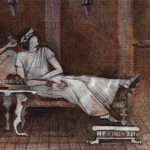Mysterious Ways
The juxtaposition of the old and the new was readily evident that busy Wednesday morning. My first patient, a 94-year-old gentleman, Hal, arrived with a precise request. His rheumatologist for the past 40 years had just retired, and he was searching for a doctor with expertise in the use of gold sodium aurothioglucose, the drug that had driven his rheumatoid arthritis (RA) into remission decades before.
Whether it was based on fact or superstition, we were taught that if gold induced a state of low disease activity, it should never be stopped. The lucky few patients who achieved remission would return monthly for their injections, ad infinitum.
Hal described the marvelous benefits of gold, and he was mystified as to why this “wonder drug” had become so difficult to procure. Although he located a pharmacy that sold an injectable gold salt product, it was of a different variety, gold sodium thiomalate (GST), a formulation that caused him great distress, with symptoms of nausea and flushing following each injection, reminiscent of the irksome nitritoid reaction, a well-recognized side effect of chrysotherapy that occurred in roughly 5% of patients taking GST.1
Hal’s physical findings were few; his joint exam findings were negligible; and his pale complexion belied his many decades of gold salt use, because there was no chrysiasis, the telltale slate-grey skin pigmentation that often identified the recipient of gold therapy to the knowledgeable eye.2
As I was meeting Hal, one of our fellows was busy disassembling a complicated tale from her new patient, Dawn, a woman about a quarter Hal’s age, whose lifelong juvenile idiopathic arthritis provided ample evidence of ongoing synovitis and prior joint damage. Over the years, the various synthetic and biologic disease-modifying drugs that stock our modern-day armamentarium had been prescribed, achieving scant success.
How odd to juxtapose the successful outcome observed in one patient who was prescribed an ancient, heavy-metal nostrum, whose mode of action in RA was poorly understood, with the failure in another patient of our newest, targeted therapies, whose constructs were based upon our sophisticated knowledge of modern-day immunology.
These anomalous outcomes serve as a reminder that medicine can still move in mysterious ways (with an homage to Bono and U2!).3 Fortunately, we are making great strides in disassembling both the innate and adaptive arms of the immune response, allowing a clearer insight into the complexities of the autoimmune responses. The accretion of knowledge that has dramatically transformed our clinical practice over the past 70-odd years can be traced to a sequence of revolutions in the clinical and basic sciences.
A Series of Revolutions
The first revolution occurred following the end of the first World War, about the time when rheumatology began organizing into a distinct specialty. Previously, clinicians with an interest in rheumatic disease tended to come from one of two fields: infectious diseases, because a commonly held belief at the time was the critical role that mycobacteria and bacteria played in the pathogenesis of chronic forms of arthritis and inflammation, and the field of physical medicine, in particular medical hydrology, a long-lost discipline that sought to incorporate the use of saunas, spas and whirlpools into clinical practice. What a life!.

